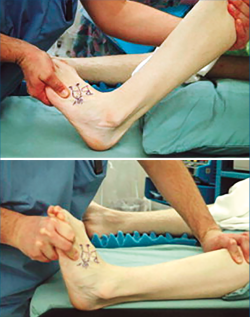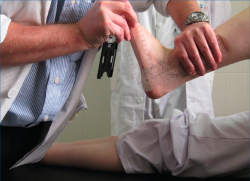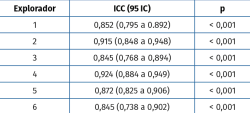Resumen
Introducción: la diferencia entre los grados de extensión del tobillo en las posiciones de extensión y flexión de rodilla nos permite valorar la retracción gemelar. Dicha retracción gemelar se ha asociado a diversas patologías de relevancia en el pie y el tobillo, como tendinopatías de Aquiles, fascitis plantares o metatarsalgias.
Objetivos: determinar la fiabilidad intra- e interobservador en la medición del acortamiento gemelar utilizando 2 métodos: el test de Silfverskiöld (test A) y el test en posición neutra del pie (test B). Se pretende también obtener los valores de normalidad de la extensión del tobillo con ambos métodos en las posiciones de extensión y flexión de rodilla.
Material y métodos: seis exploradores realizaron las mediciones en 20 sujetos sanos sin antecedentes neurológicos ni de patología traumática o degenerativa de las extremidades inferiores. Se llevaron a cabo 2 sesiones de medición con 2 semanas de diferencia. En cada una de ellas se realizó a cada sujeto 3 mediciones en cada extremidad para cada uno de los 2 test, obteniendo así 240 mediciones por sesión. Todos los exploradores utilizaron el mismo modelo de goniómetro y consensuaron una misma metodología de medición. Los resultados fueron valorados estadísticamente utilizando ICC Two-Way Random, Type Absolute Agreement.
Resultados y conclusiones: se obtuvo una fiabilidad válida tanto a nivel intraobservador como interobservador con significación p < 0,001 en ambos métodos de medición. Los valores de normalidad de extensión de tobillo con el test A fueron en extensión de rodilla 0° y en flexión 6° y con el test B fueron de 8° en extensión de rodilla y 13° en flexión. Dada esta fiabilidad intra- e interobservador, consideramos que ambos test son útiles para el diagnóstico de la retracción gemelar.
Abstract
Introduction: the difference between degrees of ankle extension in the knee extension and flexion positions allows us to assess the gastrocnemius muscle retraction. Such retraction of the gastrocnemius muscle has been associated with several relevant pathologies in the foot and ankle such as Achilles tendinopathies, plantar fasciitis or metatarsalgias.
Objectives: to determine the intra- and inter-observer reliability in the measurement of the gastrocnemius muscle shortening using 2 methods: the Silfverskiöld test (test A) and the neutral foot position test (test B). The aim is also to obtain normal values for ankle extension with both methods in the knee extension and flexion positions.
Material and methods: six examiners performed the measurements on 20 healthy subjects with no history of neurological, traumatic or degenerative pathology of the lower extremities. Two measurement sessions were carried out two weeks apart. In each session, three measurements were taken in each limb for each of the two tests, thus obtaining 240 measurements per session. All the examiners used the same goniometer model and agreed on the same measurement methodology. The results were evaluated statistically using the ICC two-way random, type absolute agreement.
Results and conclusions: valid reliability was obtained both at intra- and inter-observer levels with a significance of p < 0.001 in both measurement methods. The normal values of ankle extension with test A were 0° in knee extension and 6° in flexion and with test B were 8° in knee extension and 13° in flexion. Given this intra- and inter-observer reliability, we consider that both tests are useful for the diagnosis of gastrocnemius muscle retraction.
Artículo
Figuras y tablas
Referencias
Descargas
Licencia
Este contenido es de acceso abierto (Open-Access) y se ha distribuido bajo los términos de la licencia Creative Commons CC BY-NC-ND (Reconocimiento-NoComercial-SinObraDerivada 4.0 Internacional) que permite usar, distribuir y reproducir en cualquier medio siempre que se citen a los autores y no se utilice para fines comerciales ni para hacer obras derivadas.




